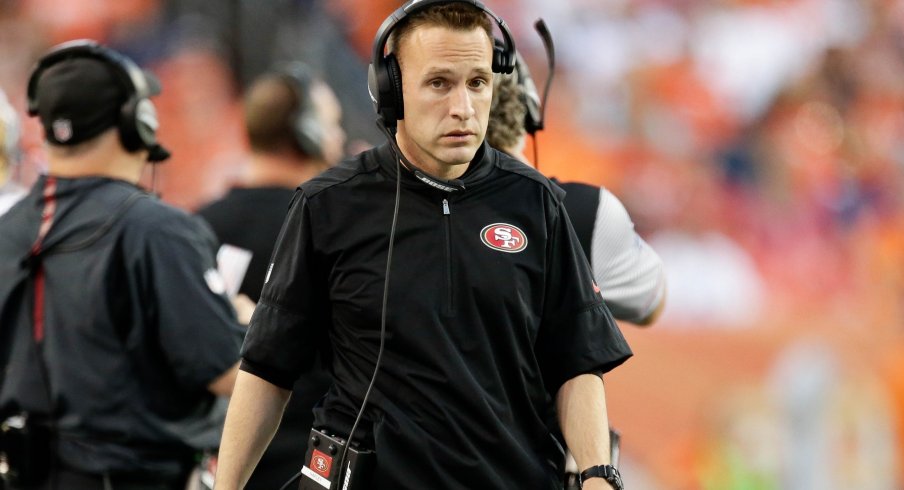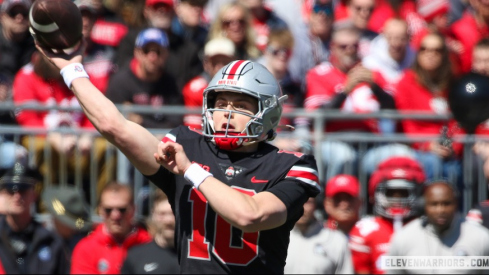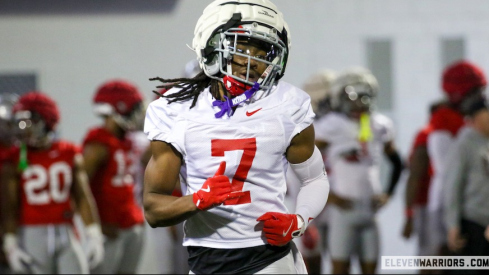“So they asked me to speak about defending the spread.”
Hundreds of high school coaches had gathered at the Columbus Easton Hilton on a cold Thursday night in February to talk ball. But this was no casual get-together over beer and wings, it was the annual Ohio High School Football Coaches Association clinic, which featured three speakers from the state's nearby flagship university.
Among the trio were two very familiar faces for the audience, Ohio State head coach Ryan Day and wide receivers coach Brian Hartline. However, a new face joined those two as well, recently minted co-defensive coordinator and secondary coach Jeff Hafley.
Hafley, of course, came from the San Francisco 49ers where he coached defensive backs for three seasons following two each with the Tampa Bay Buccaneers and Cleveland Browns. While his former players have been quite complimentary of his coaching abilities, expecting him to achieve great things in Columbus, his immediate impact on the program has been tough to gauge next to fellow coordinator Greg Mattison.
While Mattison's credentials at the college level are bonafide, Hafley's additions to the Buckeyes' new defensive system remain a mystery. In front of a crowd hungry to learn from a peer with NFL experience, Hafley provided some clues about his plans for the Ohio State secondary this fall.
“Quarters coverage is something I’ve been around a lot of,” he said at the beginning of a casual speech about his preferred method for defending spread offenses. Without showing pages from a playbook or focusing on specific techniques, Hafley walked through multiple clips of his split-safety secondary in Cleveland rather than highlighting the three-deep looks preferred by the staff in San Francisco.
“The biggest thing for me when you talk defending the spread or trying to play the passing game is distribution in numbers," Hafley told the crowd. "To me, you always want 4-on-3 and 3-on-2.”
Such a philosophy is a far cry from the single-high safety looks paired with man-coverage favored by former OSU coordinator Greg Schiano. While Schiano's defenses produced multiple stars in the secondary, such as Marshon Lattimore, Malik Hooker, and Denzel Ward, his units were also responsible for embarrassing losses to Iowa and Purdue which kept the Buckeyes out of the College Football Playoff in consecutive years.
Without star cornerbacks to shut down opposing playmakers outside, the 2018 Ohio State defense became a punching bag for high-powered spread offenses, giving up 511 total yards to TCU, 492 to Penn State, 539 to Purdue, and 535 to Maryland. Had it not been for the heroics of Dwayne Haskins and the No. 2 ranked total offense in the country, the 13-1 Buckeyes could've easily finished 9-4 instead.
Though Hafley himself once apprenticed under Schiano for three seasons at Rutgers and Tampa, the 39-year-old New Jersey native appears to be a believer in the pattern-matching coverages favored by CFP regulars like Nick Saban, Brent Venables, and former OSU coordinator Chris Ash. As many readers in this space are aware, Ash implemented his Quarters coverage system with two deep safeties upon his arrival in 2014, immediately transforming the Buckeye defense into a championship caliber unit.
Though the defense maintains the structure of zone coverage in pattern-match schemes, the individual receivers are covered with man-to-man technique, often confusing both the opposing quarterback and most television commentators in the process. While there are countless intricacies and checks in such systems (Saban's 2015 defensive playbook was an astounding 543 pages long), Hafley tries to keep things as simple as possible when teaching his players.
“The biggest thing to know when you’re teaching match routes, so say you’re teaching the nickel, then the thing you’re teaching is #2 can only do three things: he can go up, he can go out, or he can go in...It’s how I’ve taught it the last seven years, it’s how I’ll continue to teach it.”
Once the defender identifies the intentions of the receiver he's reading, he then simply follows the rules based on his position in the called coverage. For instance, in Quarters coverage (sometimes called Cover 4, 4-read, or 4-man, since the defense essentially plays a 4-deep, 3-under coverage against all-vertical routes), the cornerbacks will cover the #1 receiver (furthest outside) on any route that goes vertical (up) or out.
If the receiver breaks inside before hitting a designated landmark (this varies by coach, but is typically around 5 yards), then the corner drops back into a deep zone and looks for the #2 receiver to break in his direction on a deep corner route. The weak point in a Quarters look is the underneath flats, as the alley defender (often an outside linebacker or nickel back) must cover anything to the sideline if the #1 outside receiver takes off vertically.
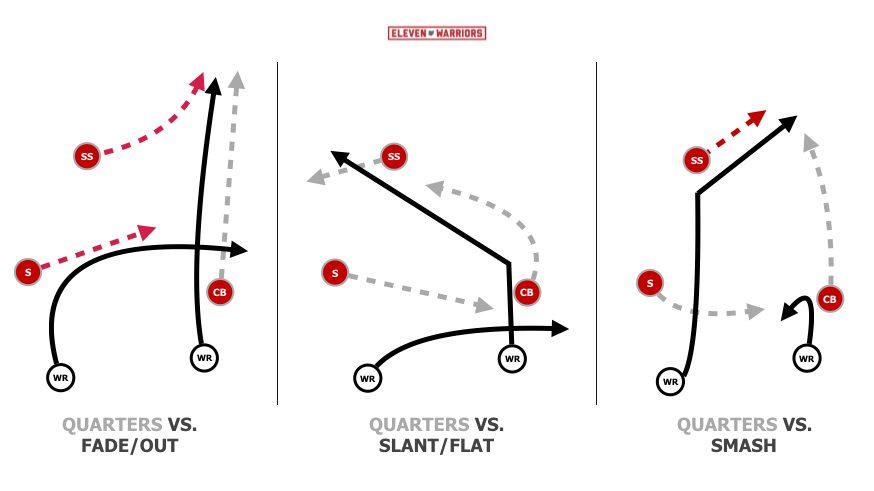
This makes the alley defender especially vulnerable as the read man in a run/pass option or simple play-action, as he's responsible for filling a run gap in addition to covering the flat against the pass. Bubble screens and quick outs are quite effective in this instance, especially when involving a speedy slot receiver that can beat the defender to the edge.
As Schiano's game plans showed last fall, any coverage has weak spots, and the defense must throw a change-up once an opposing offense proves capable of exploiting them. For Hafley and other pattern-match believers, this often means changing the way the secondary handles routes to the flat.
Based on the traditional 2-deep, 5-under Cover-2 zone defenses that were the preferred method for slowing West Coast offenses in the 1990s and 2000s, Palms coverage (a.k.a. 2-Read, Cloud, Blue, or simply Cover-2) is a is a derivative of the Quarters system allowing the cornerback to defend any out-breaking routes to the flat and leaving the deep safety to defend any deep routes from the #1 receiver.
Like Quarters, Palms/2-Read attempts to box in two receivers with three defenders over them. However, instead of reading different players, all three defenders read the #2 receiver inside (hence the name, 2-Read).
- If the #2 receiver breaks inside or vertically up the field, the corner will drop and look to pick up #1
- If #2 breaks outside before the designated landmark (usually 5 yards), the corner will jump the flat and defend #2, leaving #1 for the safety
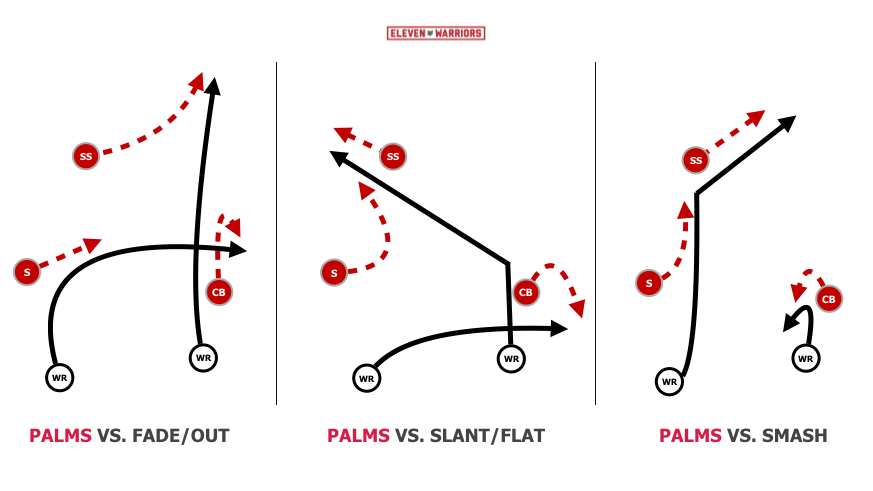
Unlike typical Quarters, in which the safeties can easily insert into the run game as extra defenders (as Michigan State did so successfully in their 2015 upset of the Buckeyes), the safeties now play much more conservatively against the pass in Palms/2-Read, leaving the underneath alley defender and cornerback to fill against the run.
(Author's note: Learn more about Palms/2-Read coverage HERE, HERE, HERE, and HERE)
If the offense sends all four receivers vertically downfield, then the coverage still looks exactly like Quarters. Only if #2 breaks outside does it look different, mimicking the 2-deep, 5-under look of traditional Cover-2 zone looks.
To some, this system of swapping back and forth between the two schemes may seem irrelevant, given the fact that Mattison will act as the primary play-caller this fall. However, as his previous playbooks showed, the former Michigan coordinator relies on both Quarters and Palms - often on the same play.
Mattison's split-field scheme known as Cover-6 asks the defenders to the wide side of the field to play Quarters, while the boundary defenders employ Palms/2-Read coverage.
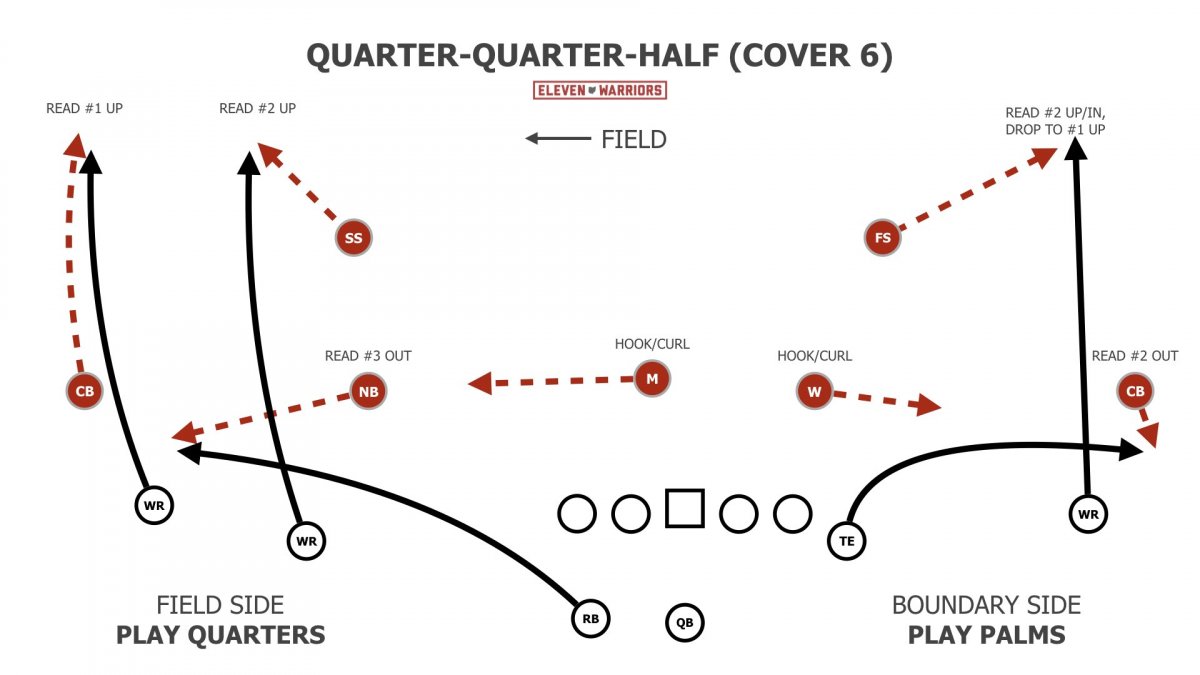
Once Hafley instills the principles of playing Palms/2-Read, Buckeye defensive backs will have plenty of opportunities to rep it. When facing 3x1 formations with three receivers to one side, Hafley likes to call a pattern-match variant known as Mini, which other coaches sometimes call Inside Palms or Special.
In this scheme, the cornerback takes the #1 receiver in man-coverage with no exceptions, known as a MEG (Man Everywhere he Goes) call. With #1 accounted for, the three other defenders inside play the same Palms/2-Read technique, treating the #3 receiver as the inside man upon which their movements are based.
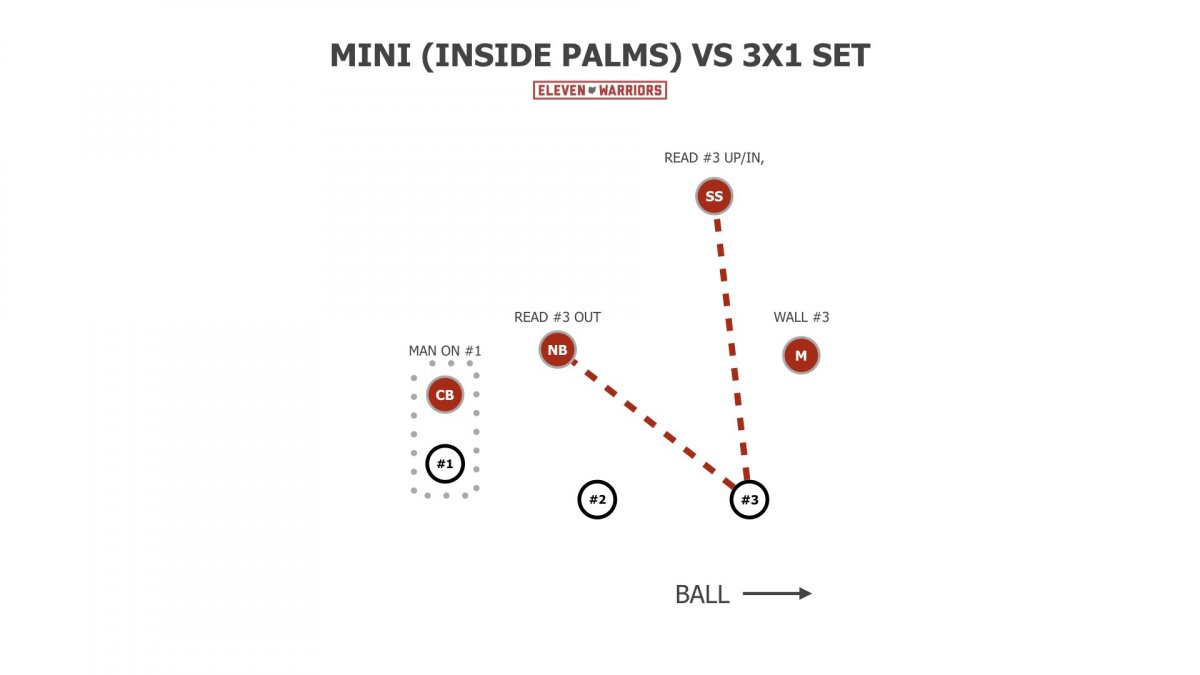
As Hafley pointed out to the coaches in attendance at the clinic, he prefers this call at the college level due to the wider hash marks. Given that the vast majority of teams align their three-receiver looks to the wide side of the field, Hafley is willing to bet a college QB isn't capable of making an accurate downfield throw from the opposite hash should the #1 receiver beat the corner one-on-one.
With the #1 receiver effectively taken out of the picture, the field is shrunk to 10-on-10 with the rest of the defense playing essentially the same coverage rules as they would against a more traditional two-receiver look.
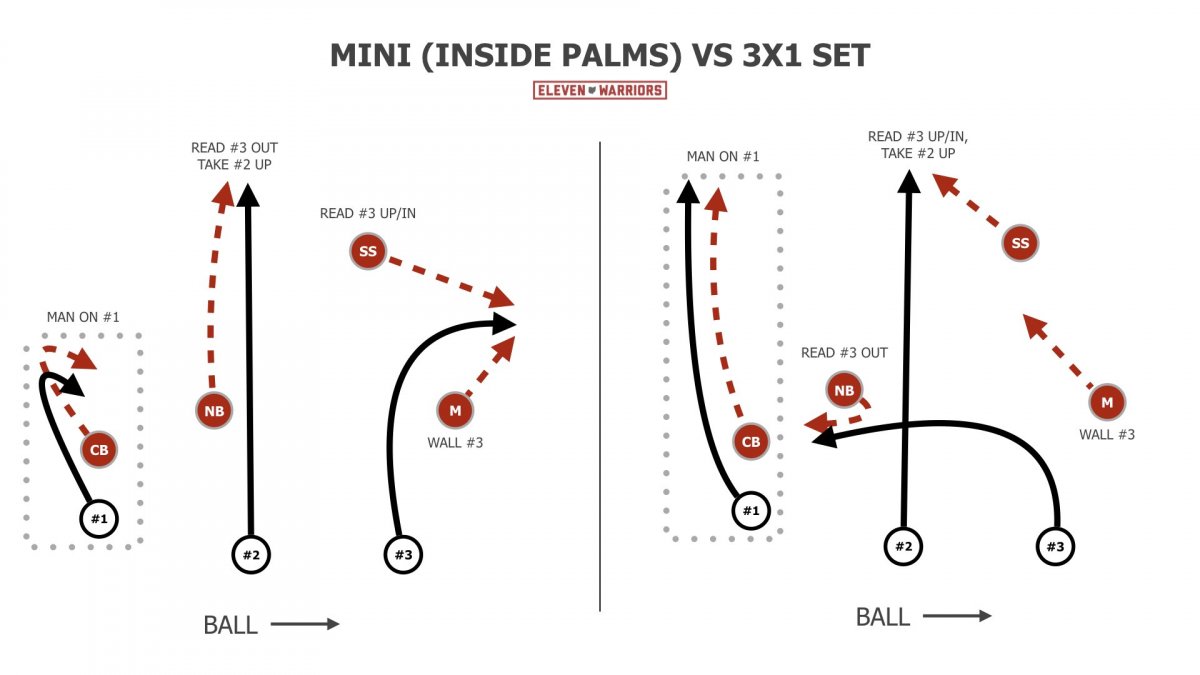
Like any coverage scheme, Hafley's 2-deep pattern-match system has weak spots. When running true Quarters looks the flats can be exposed, while Palms/2-Read coverage can be stressed by route combinations like double-slants, Mills (post/dig), and Scissors (post/corner).
But luckily for Hafley, Mattison, and the rest of the Buckeye defense, this approach leaves them with a number of different tools to combat opponents rather than relying simply on the talent of a few individual defenders in coverage.
